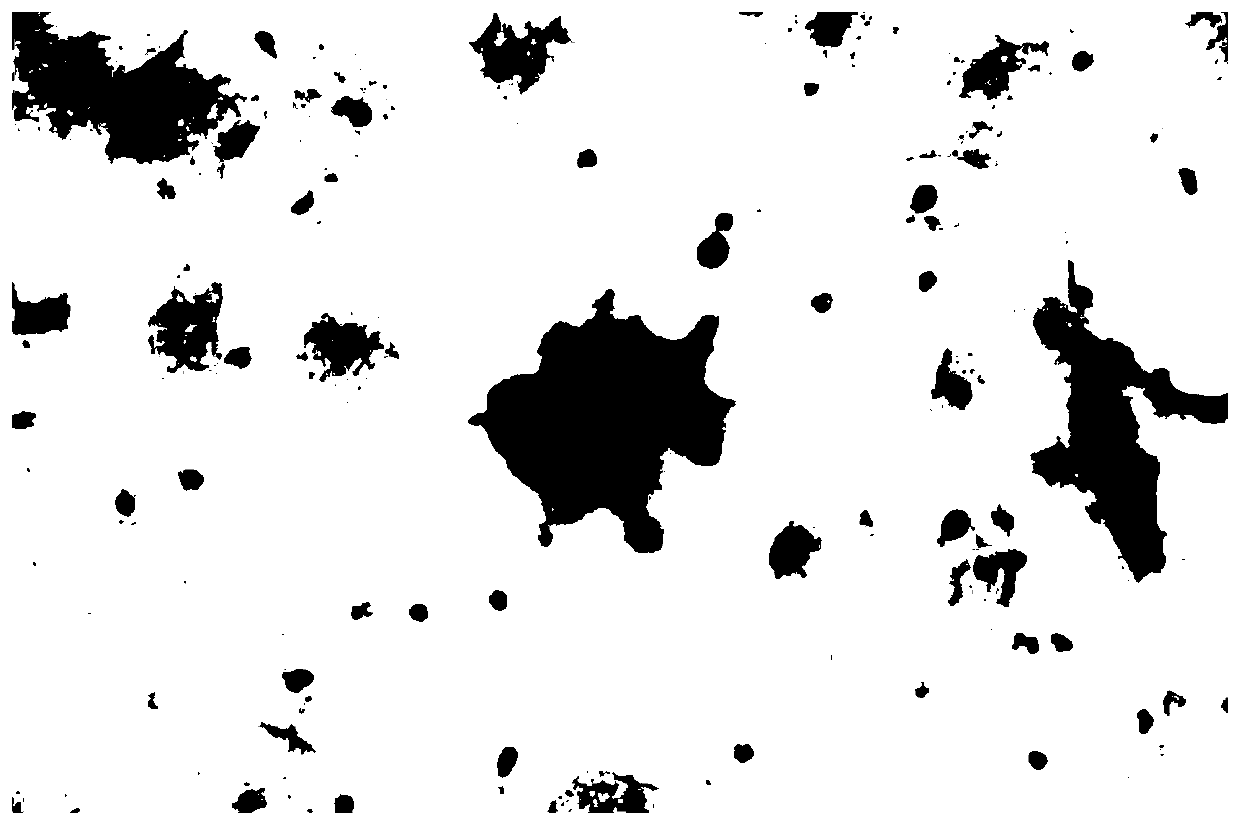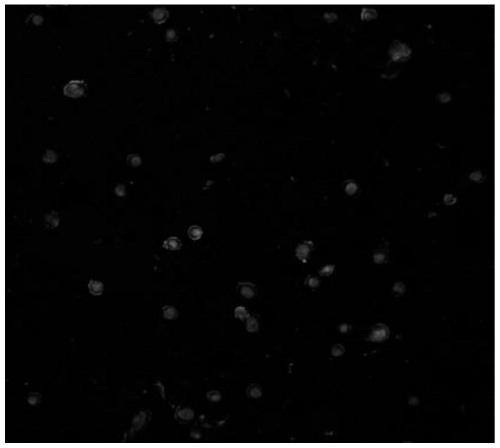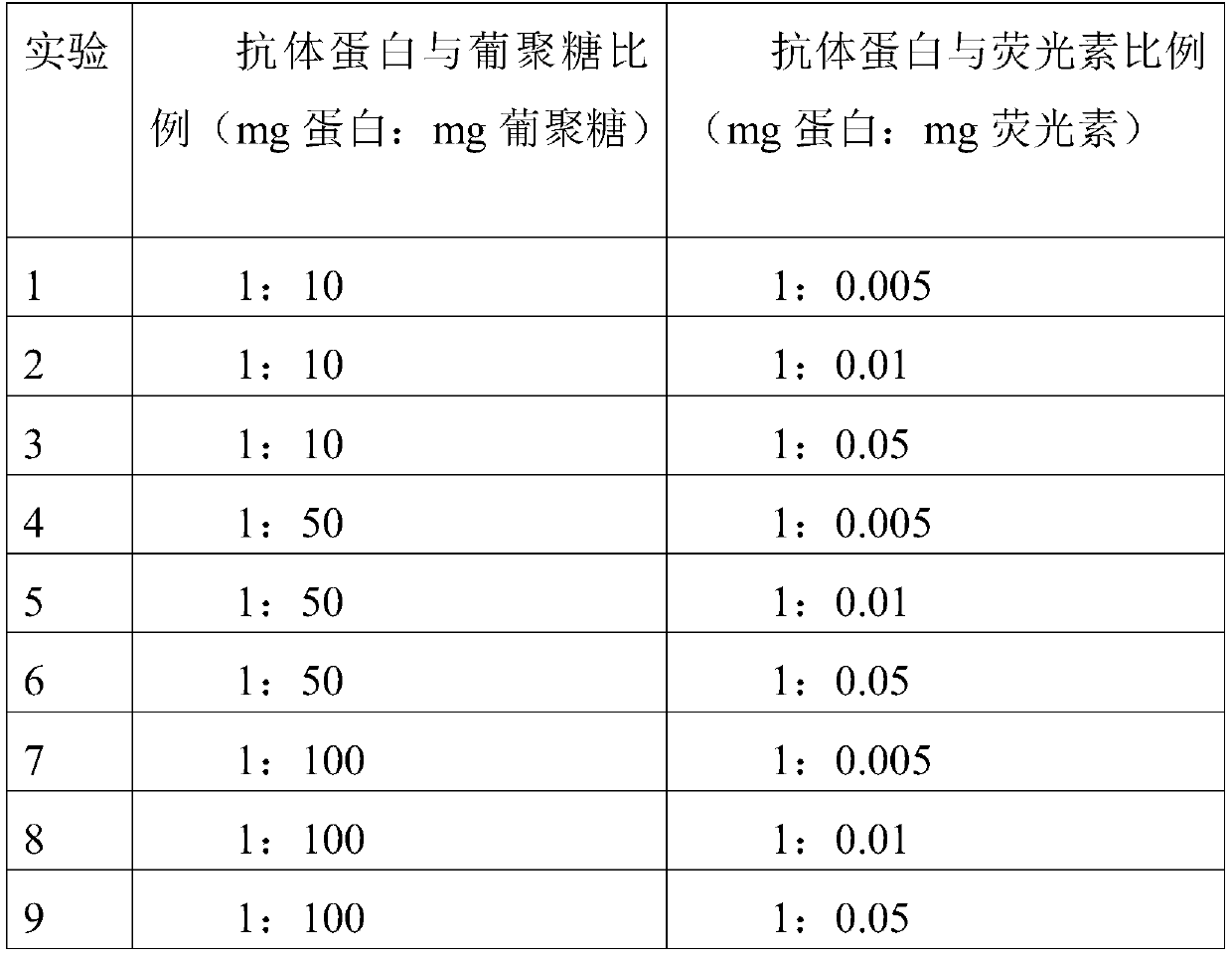Immunofluorescent double staining kit for cervical cancer auxiliary diagnosis
An auxiliary diagnosis and immunofluorescence technology, applied in the field of liquid-based cytology immunofluorescence staining, can solve the problems of low sensitivity and complexity, and achieve the effect of efficient excitation and low background.
- Summary
- Abstract
- Description
- Claims
- Application Information
AI Technical Summary
Problems solved by technology
Method used
Image
Examples
Embodiment 1
[0037] 1. Monoclonal antibody-labeled dextran amplification process:
[0038] (1) Dissolve dextran (DeX) in 20mM phosphate buffered saline (PBS) with a pH value of 7.0, add sodium periodate (NaIO 4 ) was oxidized, and the reaction was stirred at 30°C to 37°C in the dark for 2-3 hours and then terminated by adding excess ethylene glycol; the same PBS as the DeX matrix was used for dialysis overnight.
[0039] (2) Dialyze the required antibody against PBS overnight.
[0040] (3) After the oxidized DeX and the antibody were mixed and reacted, an appropriate amount of sodium cyanoborohydride (NaCNBH 3 ) The reaction time in the dark is 1.5-3 hours, and the reaction temperature is 4°C.
[0041] (4) Use sodium borohydride (NaBH 4 ) reduction, PBS dialyzed overnight.
[0042] 2. Pacific Green is a bright green fluorescent dye, which is excited by the ultraviolet laser 405nm line, and the excitation / emission wavelength is 411 / 510nm. Conjugates of this dye are strongly fluorescent...
Embodiment 2
[0071] 1. Monoclonal antibody-labeled dextran amplification process:
[0072] (1) Dissolve dextran (DeX) in 20mM phosphate buffered saline (PBS) with a pH value of 7.0, add sodium periodate (NaIO 4 ) was oxidized, and the reaction was stirred at 30°C to 37°C in the dark for 2-3 hours and then terminated by adding excess ethylene glycol; the same PBS as the DeX matrix was used for dialysis overnight.
[0073] (2) Dialyze the required antibody against PBS overnight.
[0074] (3) After the oxidized DeX and the antibody were mixed and reacted, an appropriate amount of sodium cyanoborohydride (NaCNBH 3 ) The reaction time in the dark is 1.5-3 hours, and the reaction temperature is 4°C.
[0075] (4) Use sodium borohydride (NaBH 4 ) reduction, PBS dialyzed overnight.
[0076] 2. Amplified antibody-labeled fluorescein:
[0077] (1) Ki67 antibody labeled Pacific Green
[0078] ①Preparation of 1M sodium bicarbonate solution: Weigh about 84mg of sodium bicarbonate, add 1ml of deion...
Embodiment 3
[0101] 1. Monoclonal antibody-labeled dextran amplification process:
[0102] (1) Dissolve dextran (DeX) in 20mM phosphate buffered saline (PBS) with a pH value of 7.0, add sodium periodate (NaIO 4 ) was oxidized, and the reaction was stirred at 30°C to 37°C in the dark for 2-3 hours and then terminated by adding excess ethylene glycol; the same PBS as the DeX matrix was used for dialysis overnight.
[0103] (2) Dialyze the required antibody against PBS overnight.
[0104] (3) After the oxidized DeX and the antibody were mixed and reacted, an appropriate amount of sodium cyanoborohydride (NaCNBH 3 ) The reaction time in the dark is 1.5-3 hours, and the reaction temperature is 4°C.
[0105] (4) Use sodium borohydride (NaBH 4 ) reduction, PBS dialyzed overnight.
[0106] 2. Amplified antibody-labeled fluorescein:
[0107] (1) Ki67 antibody labeled Pacific Green
[0108] ①Preparation of 1M sodium bicarbonate solution: Weigh about 84mg of sodium bicarbonate, add 1ml of deion...
PUM
 Login to View More
Login to View More Abstract
Description
Claims
Application Information
 Login to View More
Login to View More - R&D
- Intellectual Property
- Life Sciences
- Materials
- Tech Scout
- Unparalleled Data Quality
- Higher Quality Content
- 60% Fewer Hallucinations
Browse by: Latest US Patents, China's latest patents, Technical Efficacy Thesaurus, Application Domain, Technology Topic, Popular Technical Reports.
© 2025 PatSnap. All rights reserved.Legal|Privacy policy|Modern Slavery Act Transparency Statement|Sitemap|About US| Contact US: help@patsnap.com



